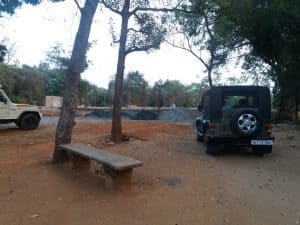The news of mass tree destruction in Anna University in mid-February had incensed the student fraternity and environmentalists in the city. The axe had fallen on the trees to make way for constructing the science and humanities building. But a visit to the campus proves that the trees were only plucked out to be transplanted scientifically, a procedure that has proved to be successful. The transplanted trees are now showing signs of life, as new leaves emerge.
While Anna University is relying on scientific procedures in saving trees, the same cannot be said of Madras Christian College, which is situated within a tropical dry evergreen forest area in Tambaram. Environmentalists allege that a lot of trees in the college have been brought down, to construct new classrooms, owing to the increase in student population.
A sad tale at MCC
The dense green cover at the Madras Christian College (MCC) has been slowly but steadily declining, with the administration cutting down trees to expand infrastructure. A student shared that at least seven trees of 15 cm circumference were brought down, a year ago, near the evening college cafe in the college.
“Species of timber and rosewood were among those that were axed down. In the recent past, the college administration has axed a lot of trees, in the name of Cyclone Vardah. They even uprooted the trees that suffered minor damages from the cyclone. Why didn’t the college administration transplant these trees?” asks the student. Students and the teachers in the college were asked to keep mum about the tree cutting.

The site where a new day cafe is going to come up at Madras Christian College (MCC). Pic: MCC student.
Besides trees, many shrubs of ecological value were cleared near the evening college cafe. At least three Neem trees and shrubs near the day college canteen were also chopped off to construct the new canteen. Explaining the importance of shrubs, Arun Konda, a botanist says, “They are home to a lot of insects and bats that play a key role in seed dispersal. A forest area with such rich habitats (as the MCC campus) is extremely important for enhancing biodiversity.”
When an eminent Swiss architect, Henry Schaetti, designed the serene Madras Christian College campus, the idea was to enable holistic learning for the students. “He designed this campus in such a way that green cover would be surrounding every building. But of late the campus has been turning into a concrete jungle since the administration is solely focused on development, compromising on environmental values,” said an informed source from the college.
Lessons from Anna University
A total of 12 trees were also uprooted from the Old International Hostel in the Anna University campus and were transplanted near the new International hostel and the quadrangle. A 100-year-old banyan tree which was allegedly chopped off still stands on campus, with its branches pruned out.
“Except for the unfriendly Prosopis Juliflora that were cleared, following the Madras High Court’s order, we did not destroy any trees. Among the transplanted ones are the species of Indian Peach and Odina Wodier,” said K Muruganantham, Horticulturist, Anna University. The University administration had cleared the Prosopis Juliflora next to the knowledge park building.
According to the horticulturist, around 1 lakh rupees was spent in transplanting the trees. “The survival rate in tree transplantation is high. Trees in the university are rich in terms of biodiversity and we don’t intend to bring them down,” added Muruganantham.
However, the University did axe down a few trees in the past, in order to construct a new hostel mess for the students.
How it is done
Tree transplantation has picked up pace in Chennai, after the ‘green’ devastation caused by Cyclone Vardah. Eminent horticulturist, B Elango said that the felled trees can be transplanted if the roots still have soil and the leaves are green.
The procedure is done by chopping the branches and applying fungicide to the roots, to prevent any diseases. “The pit for the transplantation should be treated with pesticide. It is required to spray water on the root system for a few days,” said Elango.
It takes 30-40 days for the new leaves to emerge and subsequently, three months for the roots to grow. Meanwhile, liquid manure should be sprayed regularly.
However, experts point out that tree transplantation is a complicated process. T D Babu, a marine biologist says, “Summer is not the right time for tree transplantation. Trees transplanted near Marina Beach showed signs of new leaves immediately after transplantation. But none of them are alive today.”
“It is high time we focus on development accommodating trees. We may project transplantation as a solution or planting more saplings as compensation. But we need to understand that not all tree species can be transplanted with success. Survival rates among old trees is low when transplanted,” he added.
Excellent and very good information.
you have brought the ground reality of cutting and replanting of trees in Anna University
thank you
estate office